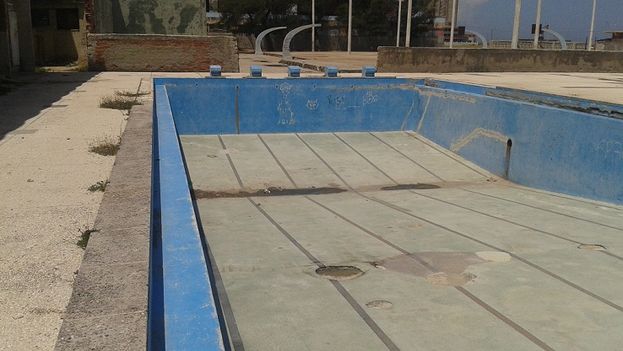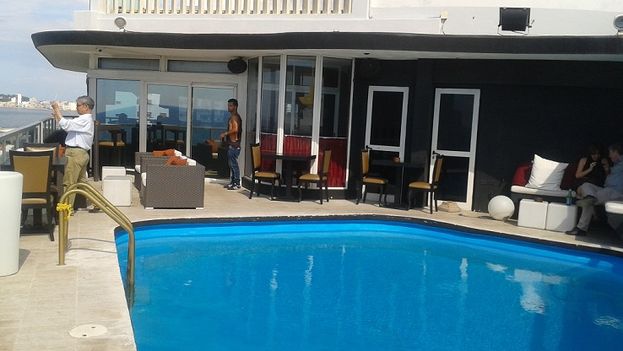
![]() 14ymedio, Rosa Lopez, Havana, 21 July 2015 — Now 67 years of age, Juan Carlos recalls how when he was a kid he climbed up on a roof and from there spied on the pool of an adjacent exclusive Havana hotel. He was fascinated by what he saw, but Juan Carlos’ family’s financial limitations kept him from enjoying all that magnificence. The slogan “The People Have a Right to Sports” had firmly taken root by his teens and early adult years. Consequently, Juan Carlos got to splash around in several pools, and for free. However, his memories of those blue waters now come back to haunt him. Today, all the pools near Juan Carlos are either in a state of total ruin or way beyond his budget.
14ymedio, Rosa Lopez, Havana, 21 July 2015 — Now 67 years of age, Juan Carlos recalls how when he was a kid he climbed up on a roof and from there spied on the pool of an adjacent exclusive Havana hotel. He was fascinated by what he saw, but Juan Carlos’ family’s financial limitations kept him from enjoying all that magnificence. The slogan “The People Have a Right to Sports” had firmly taken root by his teens and early adult years. Consequently, Juan Carlos got to splash around in several pools, and for free. However, his memories of those blue waters now come back to haunt him. Today, all the pools near Juan Carlos are either in a state of total ruin or way beyond his budget.
Currently retired, Juan Carlos insists that “access to pools in July and August should be a human right.” When summer heat waves make Cubans sweat so profusely, “there’s nothing better then taking a dip to cool off,” he says, with a confident half-smile.
The lack of chlorine, paint, failing pumps, and lack of maintenance has led to all the “Closed” notices appearing on many of the capital’s pools
After touring those places in Havana where kids once frolicked loudly as others pirouetted before plunging in, it is obvious that pools are no longer affordable to all. Public pools are the most dilapidated. The lack of chlorine, paint, failing pumps, and lack of maintenance has led to all the “Closed” notices appearing on many of the capital’s pools.
Whoever walks under the blazing sun up the street leading to the University of Havana’s Calixto Garcia Hospital would undoubtedly be upset when coming upon the faded blue paint on what used to be the University Stadium’s Swimming Pool. Lying there empty, deserted for no reason, rests the place where once upon a time students practiced their strokes, and where swimming meets between the University’s departments were held.
The same thing has happened to El Pontón, a sports and recreation center on the corner of Oquendo and Manglar Streets in Downtown Havana. El Pontón used to house two pools, one for laps and the other for diving. The latter had a thirty-foot-high diving platform. Yet all that remains of these pools is an enormous pit full of trash through which the floodwaters in this low-lying area are drained off.
“This was once full of kids,” recalled an elderly man who was trying to do his morning exercises in the midst of overgrown weeds on a field which many years ago was a baseball diamond. “A lot of us from the area would bring our kids here so that they would learn to swim,” he remembers. “I now have a fifteen-year-old granddaughter. If she falls in the water she’d drown. She’s never had the chance to swim in a pool, not even to just learn how to float.”

On the list of destruction on which appears El Pontón, one can also find the José Martí Stadium, located on the Avenue of the Presidents just a few yards from the Malecón. Youngsters now use the empty pool for soccer matches. It is also not uncommon on some nights for couples to use this pool for lovemaking under the twinkling stars. “The only thing missing in this pool is an avocado plant growing right in the middle of it. Maybe when that happens they’ll finally realize they need to fix it,” complained Fidelio, a resident of nearby “E” Street, who goes for a run on the stadium’s dilapidated track every morning.
A few blocks from the José Martí Stadium stands the Havana Riviera Hotel, opened in 1957 with twenty floors and 352 guest rooms. This enormous hotel has a pool that can be enjoyed even by those who are not guests. Admission costs 15 CUC for adults and ten for children, with a snack included that is actually eighty percent of the total price. Juan Carlos would have to not touch one single cent of his pension for a whole two months in order to enjoy such a luxury.
Aside from offering dining services and lodging in their homes, many families advertise the use of a pool as an added attraction.
Notwithstanding all the bad news, our retiree is not giving up. He asked a friend with Internet access to find him a private pool. Three days later he was handed a list with more than fifty options, almost all of them in the more upscale districts of Vedado, Miramar, and Casino Deportivo. “This one is the pool I told you about!” Juan Carlos exclaimed, with the same eagerness that as a youngster he felt when first spied on those distant blue pool waters from a rooftop. However, now he cannot afford to enjoy it.
Aside from offering dining services and lodging in their homes, numerous families also advertise the use of a pool as an added attraction. These houses are usually rented out for “fiestas de quince” (15-year-old girls’ birthday parties), weddings, or for the arrival of an émigré relative whose family wants to welcome him in one central location where they can all enjoy a relatively lavish get-together. In Havana’s most centrally located neighborhoods, enjoying a day of dips in a pool, with a couple of beverages included, and perhaps a light lunch, costs no less than ten CUC per person.
After touring all the pools he swam in his youth but that now lay in ruins, Juan Carlos also had to rule out the hotel and private home offers. The excessive prices are a reality he cannot ignore. Nevertheless, a friend lent him a 67-inch diameter inflatable pool. Last weekend he set it up on his balcony, filled it with a few buckets of water, and sat in it with a bottle of Cuban Bucanero beer in hand. He looked like a teenager. The next day, Juan Carlos was informed that a neighbor had snitched on him to the police for “excessive use of water from their building’s tank.”
Translated by José Badué
